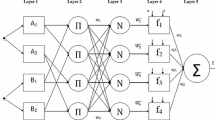Abstract
The persistence and evolution of systems essentially depend on their adaptivity to new situations. As an expression of intelligence, adaptivity is a distinguishing quality of any system that is able to learn and to adjust itself in a flexible manner to new environmental conditions and such ability ensures self-correction over time as new events happen, new input becomes available, or new operational conditions occur. This requires self-monitoring of the performance in an ever-changing environment. The relevance of adaptivity is established in numerous domains and by versatile real-world applications. The present paper presents an incremental fuzzy rule-based system for classification purposes. Relying on fuzzy min–max neural networks, the paper explains how fuzzy rules can be continuously online generated to meet the requirements of non-stationary dynamic environments, where data arrives over long periods of time. The approach proposed to deal with an ambient intelligence application. The simulation results show its effectiveness in dealing with dynamic situations and its performance when compared with existing approaches.


















Similar content being viewed by others
Notes
Actually it is not a similarity measure, since it does not satisfy the symmetry property, but it is referred to so just in the sense of closeness
With acknowledgment to Dr. Hagras for furnishing this study with the iDorm data.
References
Angelov P (2004) An approach for fuzzy rule-base adaptation using on-line clustering. Int J Approx Reason 35(3):275–289
Angelov P, Lughoferb E, Zhou X (2008) Evolving fuzzy classifiers using different model architectures. Fuzzy Sets Syst 159:3160–3182
Bouchachia A (2004) Incremental rule learning using incremental clustering. In: Proceedings of the 10th conference on information processing and management of uncertainty in knowledge-based systems, vol 3, pp 2085–2092
Bouchachia A (2004) Maintaining knowledge bases via incremental rule learning. In: Proceedings of the international workshop on soft computing for information mining, pp 51–63
Bouchachia A (2006) Incremental learning via function decomposition. In: Proceedings of the international conference on machine learning and applications, pp 63–68
Bouchachia A (2009) Encyclopedia of data warehousing and mining, chapter incremental learning, 2nd edn. Idea-Group, pp 1006–1012
Bouchachia A, Gabrys B, Sahel Z (2007) Overview of some incremental learning algorithms. In: Proceedings of the 2007 IEEE international conference on fuzzy systems, pp 1–6
Bouchachia A, Mittermeir R (2006) Towards fuzzy incremental classifiers. Soft Comput 11(2):193–207
Carpenter G, Grossberg S, Rosen D (1991) Fuzzy ART: fast stable learning and categorization of analog patterns by an adaptive resonance system. Neural Netw 4(6):759–771
de Barros J, Dexter L (2007) On-line identification of computationally undemanding evolving fuzzy models. Fuzzy Sets Syst 158(16):1997–2012
French R (1999) Catastrophic forgetting in connectionist networks: causes, consequences and solutions. Trends Cogn Sci 3(4):128–135
Fritzke B (1995) A growing neural gas network learns topologies. In: Advances in neural information processing systems, pp 625–632
Gabrys B (2002) Agglomerative learning algorithms for general fuzzy min–max neural network. J VLSI Signal Process Syst 32(1):67–82
Gabrys B, Bargiela A (2000) General fuzzy min–max neural network for clustering and classification. IEEE Trans Neural Netw 11(3):769–783
Gama J, Medas P, Castillo G, Pereira Rodrigues P (2004) Learning with drift detection. In: Advances in artificial intelligence—17th Brazilian symposium on artificial intelligence, pp 286–295
Grossberg S (1988) Nonlinear neural networks: principles, mechanism, and architectures. Neural Netw 1:17–61
Hagras H, Doctor F, Lopez A, Callaghan V (2007) An incremental adaptive life long learning approach for type-2 fuzzy embedded agents in ambient intelligent environments. IEEE Trans Fuzzy Syst 15(1):41–55
Kasabov N (2001) On-line learning, reasoning, rule extraction and aggregation in locally optimized evolving fuzzy neural networks. Neurocomputing 41:25–45
Klinkenberg R (2004) Learning drifting concepts: example selection vs. example weighting. Intell Data Anal 8(3):281–300
Kuncheva L (2004) Classifier ensembles for changing environments. In: Proceedings of the fifth international workshop on multiple classifier systems, pp 1–15
Liu F, Quek C, Ng G (2007) A novel generic hebbian ordering-based fuzzy rule base reduction approach to mamdani neuro-fuzzy system. Neural Comput 19(6):1656–1680
McCloskey M, Cohen N (1999) Catastrophic interference in connectionist networks: the sequential learning problem. Psychol Learn Motivation 24:109–164
Pedrycz W, Gomide F (1998) Introduction to fuzzy sets: analysis and design. MIT Press, Cambridge
Ratcliff R (1990) Connectionist models of recognition memory: constraints imposed by learning and forgetting functions. Psychol Rev 97:285–308
Sahel Z, Bouchachia A, Gabrys B (2007) Adaptive mechanisms for classification problems with drifting data. In: Proceedings of the 11th international conference on knowledge-based intelligent information and engineering systems (KES’07), LNCS 4693, pp 419–426
Salzberg S (1991) A nearest hyperrectangle learning method. Mach Learn 6:277–309
Sharkey N, Sharkey A (1995) Catastrophic forgetting in connectionist networks: causes, consequences and solutions. Anal Catastrophic Interference 7(3–4):301–329
Tsymbal A (2004) The problem of concept drift: definitions and related work. Technical Report TCD-CS-2004-15, Department of Computer Science Trinity College, Dublin
Widmer G, Kubat M (1996) Learning in the presence of concept drift and hidden contexts. Mach Learn 23:69–101
Author information
Authors and Affiliations
Corresponding author
Rights and permissions
About this article
Cite this article
Bouchachia, A. Fuzzy classification in dynamic environments. Soft Comput 15, 1009–1022 (2011). https://doi.org/10.1007/s00500-010-0657-0
Published:
Issue Date:
DOI: https://doi.org/10.1007/s00500-010-0657-0




